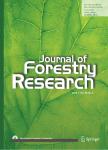Significance of the leaf epidermis fingerprint for taxonomy of Genus Rhododendron
Significance of the leaf epidermis fingerprint for taxonomy of Genus Rhododendron作者机构:Key Laboratory of Forest Plant Ecology Ministry of Education China Northeast Forestry University Harbin 150040 P. R. China National Arboretum Korea Forest Service Pochen-Gun 487-820 Korea
出 版 物:《Journal of Forestry Research》 (林业研究(英文版))
年 卷 期:2006年第17卷第3期
页 面:171-176页
核心收录:
学科分类:0710[理学-生物学] 071001[理学-植物学] 07[理学]
基 金:This work was supported by the Korea Research Foun-dation and The Korean Federation of Science and Technology Socities Grant funded by Korea Government (MOEHRD Basic Research Promotion Fund) (Project No. 032-4-1)
主 题:Taxonomy Significance Epidermal Fingerprint Stomata Trichome Rhododendron.
摘 要:Leaf epidermal fingerprints of six species of Rhododendron ( Rh. Aureaum, Rh. dauricum, Rh. micranthum, Rh. Mucronulatum, Rh. Redowskianum, Rh. schlippenbachii) were observed by optical microscope with nail polish expression method in Key Laboratory of Forest Plant Ecology of Ministry Education China in Northeast Forestry University in 2004. The leaf morphological features including of stomata types, characters of guard cells, subsidiary cells in lower epidermis were observed. And ordinary cells (in shape and anticlinal walls feature) as well as the trichomes in both sides of the leaves are described in detail. The results showed that there were three types of stoma in six investigated Rhododendron species, from which Pericytic stomata type exists in three species (Rh. dauricum, Rh. micranthum, and Rh. mucronulatum), Anomocytic stomatal type in Rh. Redowskianum, Diacytic stomata type in Rh. aureaum and Rh. schlippenbachii. The subsidiary cells of the Pericytic and Diacytic stomata type are different in shape and surface feature between the species, respectively. The ordinary epidermal cells show a variety from quadrangular to hexagonal, polygonal or irregular in surface view, the anticlinal walls are straight or sinuose. Trichomes (gland scales) are present in the both of the leaf sides in three species (Rh. dauricum, Rh. micranthum, and Rh. mucronulatum). All of these detail leaf features show specific specificity of leave finger print for 6 rhododendrons.



